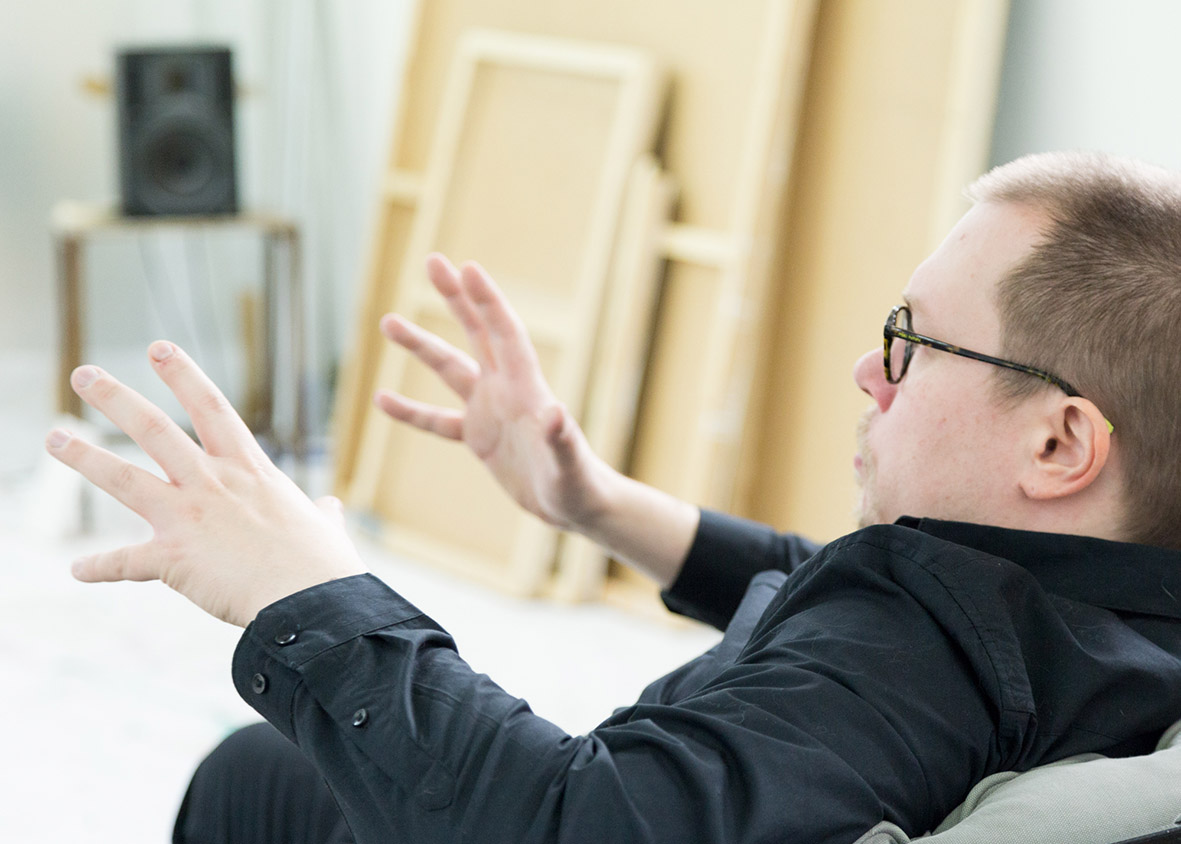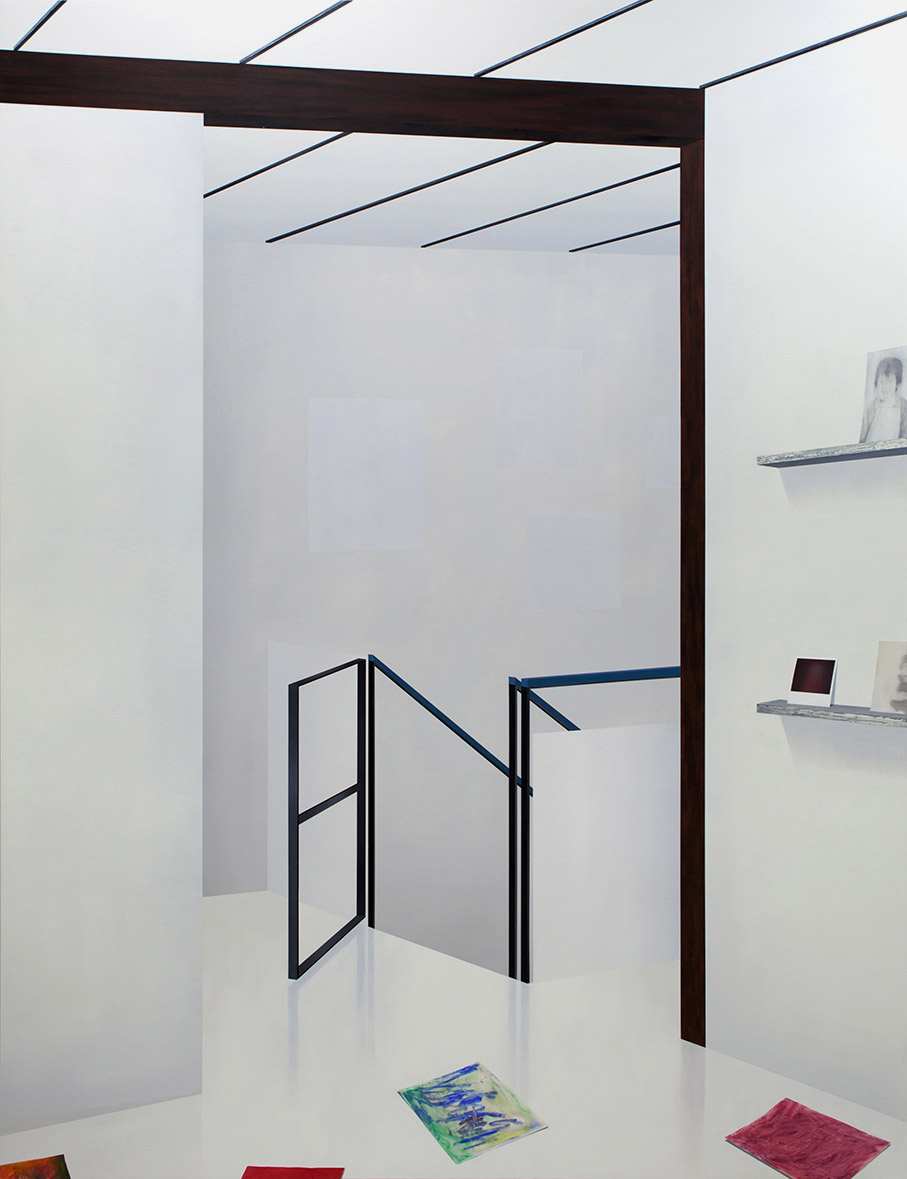Interview with artist Sampo Apajalahti for #100artinhelsinki
As a part of the #100artinhelsinki project Irene Suosalo will interview 6 interesting contemporary artists. The interviews will be published during spring 2018 on our website. As the first artist, Irene met Sampo Apajalahti at his studio whilst he was exhibiting ”Painter” at TM Gallery in Helsinki. The gallery is Finnish Painters’ Union gallery in the center of Helsinki, focusing on painting and site-specific projects.

Sampo, tell us about your background and how did you end up painting?
S: “As a child I enjoyed drawing and painting, my home had an artistic atmosphere. My mother is a graphic designer and my dad worked in the film industry. My childhood home was an atelier house. In the 1980s our neighbours were abstract painters Paul Osipow and Seppo Kärkkäinen, just to name a few. When I was about 23 or 24 years old I encountered a spark that made me want to become a professional artist. Before that I wasn’t really interested in anything and I guess visual arts filled a hole in my life. Since then, I have studied fine art at Pekka Halonen’s Academy and later at the Academy of Fine Arts in Helsinki.
Studying fine art made it possible to experiment with all types of techniques and art forms and for a long time I used various techniques on two-dimensional surfaces: watercolors, acrylic paint, a variety of tempera, oil paints, gouache, ink and pencil drawing, metal graphics, monotypes and analog black & white photography. Due to the lack of time I had to slowly eliminate some of the techniques, I ended up focusing on the use of oil paint and digital photography. Lately I’ve focused on the painting and sketching that comes with it. Only now have I found my identity as a painter in the way I feel some professional pride within my practice. “


 Describe the aesthetics of your works.
Describe the aesthetics of your works.
S: “My works are refined, traditional and suggestive.”
Where do you get inspiration?
S: “Once my inspiration came from looking at artworks I admired. Nowadays I no longer need inspiration from other artists as my work proceeds on its own terms, turning into its own inspiration. As I make figurative paintings I am constantly drawn to visual influences. Even though I consider myself a traditional painter, I take note of these by taking pictures on my phone and camera. Though of course other experiences influence my work to some degree: I especially like music with a large sampling and films for their holistic nature.”
How has your working developed?
S: “In recent years, my work’s become more systematic and determined. In most cases I know what I’m doing and striving for. Obviously when doing similar things for a long time, the knowledge and skills, and thus the work, evolve. Surely surprises and mistakes still happen. I’ve become more understanding and accepting to the concept of time and practice: It is okay if a painting takes four months or more to finish. My working process is on and off, I don’t work on a painting constantly. Personally I think that the worst and most fatal mistake an artist can make, is to let themselves go too easily. So nowadays I intentionally set the bar higher for myself.”
What do you want to say with your works and why these topics?
S: “My works are psychologically loaded poetic performances. Rather than declare they suggest. Thus, my works don’t have any unequivocal message. They loosely handle time, the process of time and individual’s relationship to a certain place. I use a lot of personal material from my childhood. But character isn’t the absolute value of my work, rather than that I try to make them public despite the starting point. The visual look of my work is also an essential value in itself, and in that sense I work in a fully intuitive way on the basis of what I think seems interesting and artistically convincing.”
 Do your works comment on any of the current social and political problems?
Do your works comment on any of the current social and political problems?
S: “They don’t comment in any way. I’m interested in social issues. For example I critically relate to the political majority that’s in Finland at the moment. But I feel like art is rarely an effective tool for commenting on political issues. Politically charged art too often portrays the artists subjective opinion. People with the same mind set nod their heads, identifying with it. But of course, there is a lot of impressive political art: For example in my own case, the politically charged paintings made by Teemu Mäki at the beginning of 21th century, made a great impression and even directly influenced my choice of profession. In the case of his work, however, the straightforwardness and fierce expression and phenomenal painting skills were striking.”
How do you see the artist’s status in Finland and in the midst of the current state of the world?
S: “On a daily level, visual artists in Finland are quite hard-pressed, since there are many doers and little money to be distributed. However, I believe that people who work long-term and stand up from the mass, in one way or another, always find their way. In general, all artists, regardless of their art form, are always marginal, and the world is not exactly changed through art. On the other hand, art will always offer experiences and thoughts to people who are willing to open themselves to mechanisms affecting emotions and thinking. Perhaps the greatest fineness of art lies in its diversity and the truly infinite spectrum of subjective art experiences.”
#100artinhelsinki is a Finnish Art Agency’s project in which photographer Irene Suosalo keeps up with art events, exhibitions and gallery openings happening in Helsinki while also getting to interview few rising artists on their work.
Sampo Apajalahti: Painter Erottajankatu 9 B (courtyard)
00130 Helsinki
Open until 4pm today, 1st of April 2018.


Pictures:
Portraits of Sampo Apajalahti by Irene Suosalo.
First painting:
Plan
2018
Acrylic, oil and pencil on mdf-board 175x160cm
Second painting:
Sampo Apajalahti: Upstairs, Oil on mdf-board, 240 cm x 185 cm, 2017

